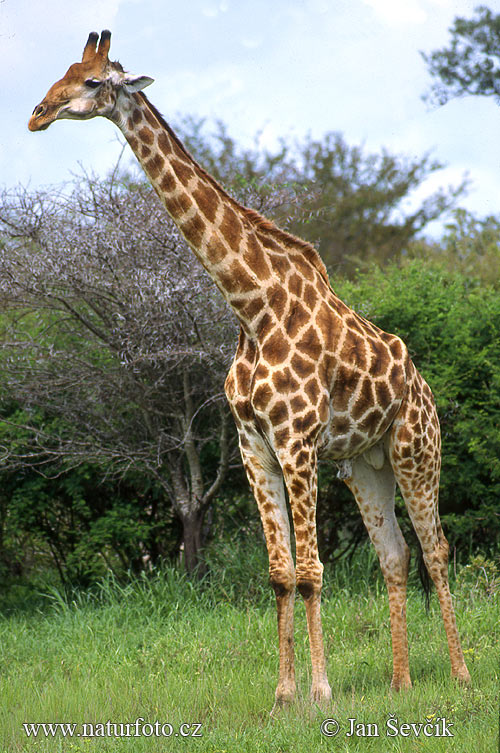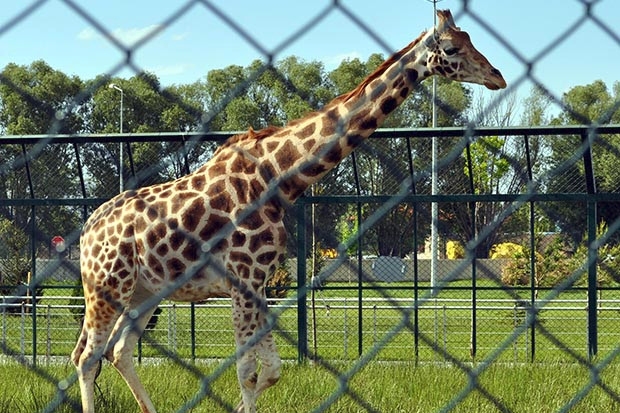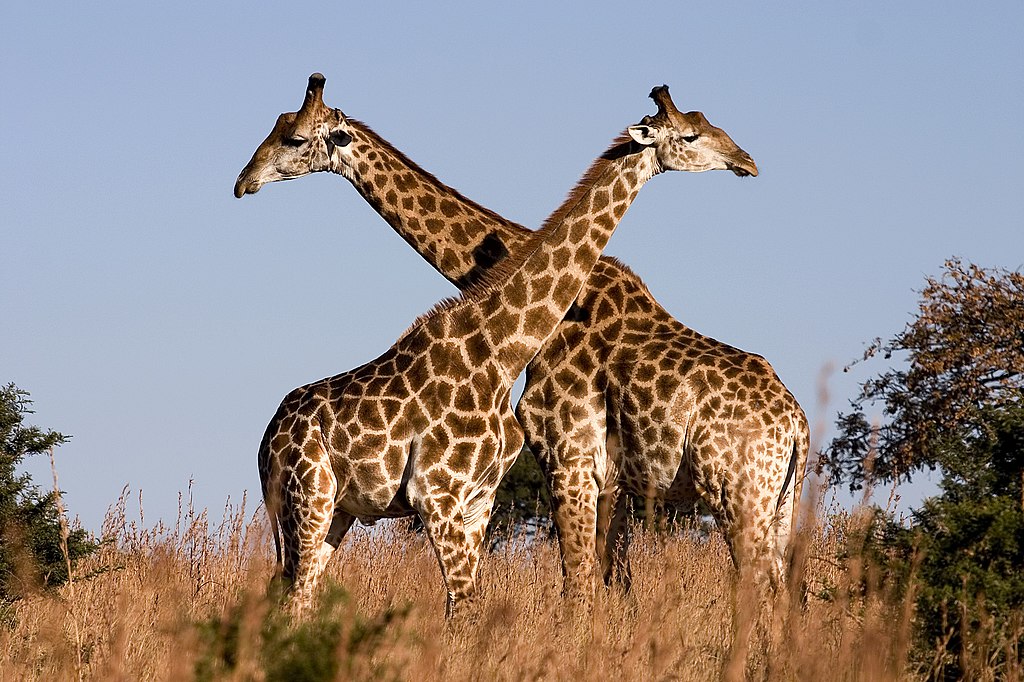Giraffe: A Majestic Creature of the African Savanna
Giraffe: A Majestic Creature of the African Savanna
The giraffe, a majestic mammal with its distinctive long neck, is native to various regions of Africa. These magnificent creatures are primarily found in savannas, forests, and shrublands. They are generally known to be calm and peaceful animals, and their interactions with humans can often be harmonious.
Physical Characteristics of Giraffes:
Giraffes possess several unique physical features that set them apart from other animals. Their most notable feature is their incredibly long necks and large body structures. On average, a giraffe stands between 5 to 6 meters tall, with adult giraffes typically weighing over a ton. Their long necks enable them to reach high branches and leaves for feeding. Additionally, giraffes have long legs and large ears. Their skin coloration usually ranges from shades of brown, adorned with irregularly distributed spots across their bodies.
Habitats of Giraffes:
Giraffes are predominantly found in various regions across the African continent. These regions include countries such as Kenya, Tanzania, South Africa, Namibia, and Botswana. Their habitats typically consist of open savannas, forest edges, and shrubby areas. However, their natural habitats are increasingly diminishing, posing a threat to the survival of giraffes.
Feeding Habits of Giraffes:
Giraffes are herbivores, primarily feeding on the leaves and branches of trees. Their long necks provide them with an advantage in reaching high branches and foliage. The tongues of giraffes are long enough to pluck leaves from thorny tree branches without causing harm. They primarily meet their nutritional needs by consuming fresh leaves from the tops of trees. However, giraffes occasionally feed on shrubs and, rarely, fruits or grass.
Social Behaviors of Giraffes:
Giraffes are generally considered social animals. They often roam in small groups and engage in social interactions when they come together. Communication among giraffes typically occurs through body language, vocalizations, and scents. In some instances, giraffes have been observed showing affection towards one another by licking or nuzzling. Additionally, there is a hierarchical structure among giraffes, although this hierarchy is usually maintained peacefully.
Reproductive Behaviors of Giraffes:
Giraffes typically reproduce during mating seasons. Females usually mate with a single male, and the gestation period lasts approximately 15 months. A newborn giraffe calf is typically around 1.8 meters tall and grows rapidly after birth. Calves can stand within a few hours of birth and begin walking within a few days. They are cared for and protected by their mothers, although other adult giraffes may also assist in protection.
Threats to Giraffes and Conservation Status:
Giraffes face various threats, including hunting, habitat loss, and human impact. Particularly, the increasing human population in regions where giraffes reside has led to habitat loss and escalating conflicts between giraffes and humans. Additionally, illegal hunting poses a significant threat to giraffe populations. As a result, various measures are being taken to conserve giraffes, but their populations continue to decline, underscoring the need for global efforts to protect and sustainably manage their habitats.
Conclusion
Giraffes, with their unique physical attributes and graceful behaviors, are among the most captivating members of the animal kingdom. However, their populations are dwindling due to human influence and natural threats. Therefore, the conservation and sustainable management of giraffe habitats are of paramount importance. A concerted global effort is required to ensure the continued existence of these fascinating creatures for generations to come.

Kaynakça
- ^ "Mindat.org". www.mindat.org. 16 Temmuz 2020 tarihinde kaynağından arşivlendi. Erişim tarihi: 15 Haziran 2021.
- ^ "Giraffa". Mindat.org.
- ^ "Definition of CAMELOPARD". m-w.com. Encyclopædia Britannica: Merriam-Webster. 25 Nisan 2009 tarihinde kaynağından arşivlendi. Erişim tarihi: 3 Eylül 2014.
- ^ "Giraffe". Online Etymology Dictionary. 19 Mart 2015 tarihinde kaynağından arşivlendi. Erişim tarihi: 1 Kasım 2011.
- ^ Peust, C. (2009). "Some Cushitic Etymologies". Dolgopolʹskiĭ, A.; Takács, G.; Jungraithmayr, H. (Ed.). Semito-Hamitic Festschrift for A.B. Dolgopolsky and H. Jungraithmayr. Reimer. ss. 257-60. ISBN 978-3-496-02810-9.
- ^ "giraffe | Origin and meaning of giraffe by Online Etymology Dictionary". www.etymonline.com (İngilizce). 16 Ekim 2017 tarihinde kaynağından arşivlendi. Erişim tarihi: 31 Ocak 2021.
- ^ "zürafa". Nişanyan Sözlük. 19 Temmuz 2020 tarihinde kaynağından arşivlendi. Erişim tarihi: 31 Ocak 2021.
- ^ Hassanin, A.; Douzery, E. J. P. (2003). "Molecular and morphological phylogenies of Ruminantia and the alternative position of the Moschidae". Systematic Biology. 52 (2): 206-28. doi:10.1080/10635150390192726. PMID 12746147.
- ^ a b c d e f g h i Mitchell, G.; Skinner, J. D. (2003). "On the origin, evolution and phylogeny of giraffes Giraffa camelopardalis" (PDF). Transactions of the Royal Society of South Africa. 58 (1). ss. 51-73. doi:10.1080/00359190309519935. 4 Kasım 2017 tarihinde kaynağından (PDF) arşivlendi. Erişim tarihi: 25 Mayıs 2016.
- ^ a b c d Danowitz, M.; Vasilyev, A.; Kortlandt, V.; Solounias, V. (2015). "Fossil evidence and stages of elongation of the Giraffa camelopardalis neck". Royal Society Open Science. Cilt 2. s. 150393. doi:10.1098/rsos.150393.
- ^ Danowitz, M.; Domalski, R.; Solounias, N. (2015). "The cervical anatomy of Samotherium, an intermediate-necked giraffid". Royal Society Open Science. Cilt 2. s. 150521. doi:10.1098/rsos.150521.
- ^ Simmons, R. E.; Scheepers, L. (1996). "Winning by a Neck: Sexual Selection in the Evolution of Giraffe" (PDF). The American Naturalist. 148 (5): 771-86. doi:10.1086/285955. 23 Ağustos 2004 tarihinde kaynağından (PDF) arşivlendi.





























































